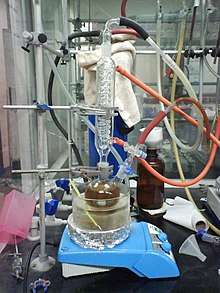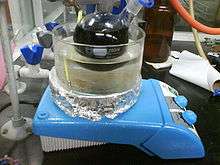Ketyl


A ketyl group in organic chemistry is an anion radical that contains a group R2C−O•. It is the product of the 1-electron reduction of a ketone.
Another mesomeric structure has the radical position on carbon and the negative charge on oxygen.[1]
Ketyls can be formed as radical anions by one-electron reduction of carbonyls with alkali metals. Sodium and potassium metal reduce benzophenone in THF solution to the soluble ketyl radical. Ketyls are also invoked as intermediates in the pinacol coupling reaction.
Reactions
Water
The ketyl radicals derived from the reaction of sodium and benzophenone is a common laboratory desiccant. Ketyls react quickly with the water and with oxygen. Thus, the deep purple coloration qualitatively indicates dry, oxygen-free conditions. The method for drying, while popular in some laboratories, is inferior in terms of safety and effectiveness relative to molecular sieves.[2]
Reducing agent
Potassium-benzophenone ketyl is used as a reductant for the preparation of organoiron compounds.[3]
References
- ↑ IUPAC, Compendium of Chemical Terminology, 2nd ed. (the "Gold Book") (1997). Online corrected version: (2006–) "ketyls".
- ↑ Williams, D. B. G., Lawton, M., "Drying of Organic Solvents: Quantitative Evaluation of the Efficiency of Several Desiccants", The Journal of Organic Chemistry 2010, vol. 75, 8351. doi: 10.1021/jo101589h
- ↑ Plotkin, J. S.; Shore, S. G. (1981). "Convenient preparation and isolation of pure potassium cyclopentadienyldicarbonylferrate, K[(η5-C5H5)Fe(CO)2]". Inorg. Chem. 20: 284–285. doi:10.1021/ic50215a060.
